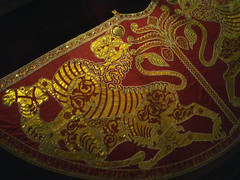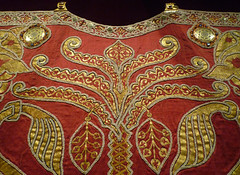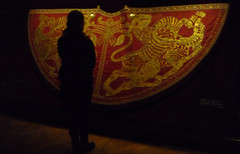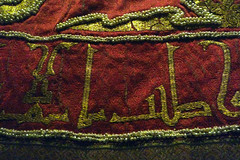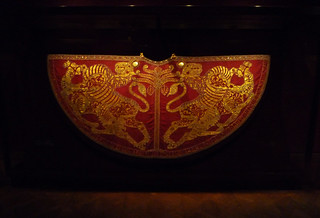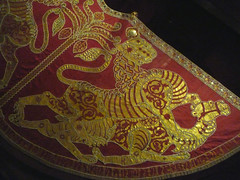3.7: Coronation Mantle
- Page ID
- 160685
\( \newcommand{\vecs}[1]{\overset { \scriptstyle \rightharpoonup} {\mathbf{#1}} } \)
\( \newcommand{\vecd}[1]{\overset{-\!-\!\rightharpoonup}{\vphantom{a}\smash {#1}}} \)
\( \newcommand{\id}{\mathrm{id}}\) \( \newcommand{\Span}{\mathrm{span}}\)
( \newcommand{\kernel}{\mathrm{null}\,}\) \( \newcommand{\range}{\mathrm{range}\,}\)
\( \newcommand{\RealPart}{\mathrm{Re}}\) \( \newcommand{\ImaginaryPart}{\mathrm{Im}}\)
\( \newcommand{\Argument}{\mathrm{Arg}}\) \( \newcommand{\norm}[1]{\| #1 \|}\)
\( \newcommand{\inner}[2]{\langle #1, #2 \rangle}\)
\( \newcommand{\Span}{\mathrm{span}}\)
\( \newcommand{\id}{\mathrm{id}}\)
\( \newcommand{\Span}{\mathrm{span}}\)
\( \newcommand{\kernel}{\mathrm{null}\,}\)
\( \newcommand{\range}{\mathrm{range}\,}\)
\( \newcommand{\RealPart}{\mathrm{Re}}\)
\( \newcommand{\ImaginaryPart}{\mathrm{Im}}\)
\( \newcommand{\Argument}{\mathrm{Arg}}\)
\( \newcommand{\norm}[1]{\| #1 \|}\)
\( \newcommand{\inner}[2]{\langle #1, #2 \rangle}\)
\( \newcommand{\Span}{\mathrm{span}}\) \( \newcommand{\AA}{\unicode[.8,0]{x212B}}\)
\( \newcommand{\vectorA}[1]{\vec{#1}} % arrow\)
\( \newcommand{\vectorAt}[1]{\vec{\text{#1}}} % arrow\)
\( \newcommand{\vectorB}[1]{\overset { \scriptstyle \rightharpoonup} {\mathbf{#1}} } \)
\( \newcommand{\vectorC}[1]{\textbf{#1}} \)
\( \newcommand{\vectorD}[1]{\overrightarrow{#1}} \)
\( \newcommand{\vectorDt}[1]{\overrightarrow{\text{#1}}} \)
\( \newcommand{\vectE}[1]{\overset{-\!-\!\rightharpoonup}{\vphantom{a}\smash{\mathbf {#1}}}} \)
\( \newcommand{\vecs}[1]{\overset { \scriptstyle \rightharpoonup} {\mathbf{#1}} } \)
\( \newcommand{\vecd}[1]{\overset{-\!-\!\rightharpoonup}{\vphantom{a}\smash {#1}}} \)
by DR. STEVEN ZUCKER and DR. BETH HARRIS
Video \(\PageIndex{1}\): Coronation Mantle, 1133/34, fabric from Byzantium or Thebes, samite, silk, gold, pearls, filigree, sapphires, garnets, glass, and cloisonné enamel, 146 x 345 cm (Schatzkammer, Kunsthistorisches Museum, Vienna)
This was likely made for the Norman ruler Roger II in 1133/34 in the royal workshop in Palermo, using fabric from Byzantium or Thebes, Samite, silk, gold, pearls, filigree, sapphires, garnets, glass, and cloisonné enamel. The Kufic script reads:
This mantle was worked in the most magnificent clothing workshop and is connected with the desire and hopes, felicitous days and nights without cease or change, with authority, with honor and felicity, assurances of trust, reverent care, protection, good destiny, freedom from harm, triumph and livelihood in the capital city of Sicily in the year 528 [or 1133/34 in the Gregorian calendar].
Additional resources:
Eva R. Hoffman, “Pathways of Portability: Islamic and Christian interchange from the tenth to the twelfth century,” Art History, vol. 24. no. 1 (February 2001), pp. 17-50.





